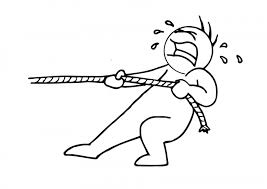 “There are two ways of exerting one’s strength: one is pushing down, the other is pulling up.” —Booker T. Washington
“There are two ways of exerting one’s strength: one is pushing down, the other is pulling up.” —Booker T. Washington
The saddest thing about business and success is the internal political games that some people are willing to play in order to get themselves ahead. There are two different ways of getting to the top and they both look very different and have different impacts on your ability to lead. You can get to the top by pulling others up; serving them, inspiring them, and encouraging them. Or, you can get to the top by pushing others down in an attempt to make yourself look better and eliminate any competition. When you pull others up you serve in a hero role; you earn trust, respect, and loyalty. When you push others down you become the enemy; losing all trust, respect, and influence. Here are three questions to help you determine if you are pulling or pushing.
Do you see others as being capable and willing to do the task at hand? If you have the attitude that you are the only one capable of doing things right, I guarantee you are pushing others down. Recognizing the strengths that others bring to the table and giving them the opportunity and support to use those strengths is the trademark of a leader who is pulling others up.
Do you inspire others? Do they trust and respect you? Without these things you do not have influence. If you do not have influence you cannot lead effectively. You gain the ability to inspire others and you earn their trust and respect by being a leader who reaches out and helps them along. If you continually push others down, you may have the false illusion that you have influence, but your employees know different.
If you are unwilling to invest your time and resources into building others up, then you are selfishly pushing them down. I’m sure you had a mentor at some point in your career, someone who you looked up to, someone who was willing to invest their time and energy into showing you the ropes and helping you grow. These are the true leaders. When you are unwilling to mentor others, you appear to have a hidden agenda. Employees will feel that you are withholding pertinent information in an attempt to make yourself look better.
Whether you are pulling others up or pushing them down, it will be reflected in your attitude, your ability to influence, and your willingness to invest in others. True leadership is about pulling others up, making them look good, and helping them to become the best they can be. This is the type of leadership that actually makes you, as the leader, look good. When you are pushing others down as you climb your way to the top, you are really showing everyone that you are not actual leadership material at all. Leadership is not about you so reach down and start pulling others up!
© 2017 Elizabeth Stincelli
Liz Stincelli is passionate about recognizing and inspiring the leader in each of us. She is the Founder of Stincelli Advisors where she focuses on helping organizations change attitudes, change communication dynamics, improve collaboration and problem-solving, engage employees, and strengthen organizational culture. Liz holds a Doctor of Management degree with an emphasis on organizational leadership.
Learn more about Liz by visiting her website, stincelliadvisors.com and connect with her on Twitter @infinitestin, Google+, and LinkedIn. You can contact her by email at stincelliadvisors@gmail.com.
 “Whatever you do in life, surround yourself with smart people who’ll argue with you.” —John Wooden
“Whatever you do in life, surround yourself with smart people who’ll argue with you.” —John Wooden
We hear some version of it all the time, “you are the sum of the five people you spend the most time with.” You want to surround yourself with people who have achieved the things you want to achieve, or at least have the same aspirations that you do. We pick up on their behaviors and habits. We get to opportunity to connect with others in their network. And, they help us see things from a whole new perspective. So, when you take a look around, who are you surrounding yourself with?
Russell Simmons advised us, “Surround yourself with people who are smarter than you.” You’ve heard the saying that if you are the smartest person in the room, you’re in the wrong room. You need to surround yourself with people who are smart enough to challenge you. You want to be around people who you can learn from, people who have had experiences that are fascinating and backgrounds that are full of lessons learned.
Brian Koslow told us, “Surround yourself with people who believe in you.” While you don’t want to be the smartest person in the room, you do want to surround yourself with those who believe in you and can see what you are truly capable of. When people believe in you, they want the best for you. You never want to surround yourself with those who are only looking out for their own best interests. Surround yourself with people who inspire you to become better and ignite a fire in you to achieve your loftiest dreams.
Sarah Gavron stated, “Surround yourself with people who support you. Find champions.” To go along with believing in you, you want to surround yourself with those who are supportive of you. You need to find cheerleaders who are on your side. You do not, however, need to surround yourself with ‘yes men’. You need people who will be honest with you; the good; the bad; and the ugly, but will be there standing by your side just the same.
Who are you surrounding yourself with? Are they smarter than you? Do they believe in you? Do they support you? Find people who will challenge you but who also have your best interests at heart and believe in you. And, at the end of the day, remember that it is a two-way street. We benefit as much from sharing our knowledge with and challenging others, believing in them and encouraging them to chase their dreams, and standing by their side supporting them just as much, if not more than, them being there for us.
© 2017 Elizabeth Stincelli
Liz Stincelli is passionate about recognizing and inspiring the leader in each of us. She is the Founder of Stincelli Advisors where she focuses on helping organizations change attitudes, change communication dynamics, improve collaboration and problem-solving, engage employees, and strengthen organizational culture. Liz holds a Doctor of Management degree with an emphasis on organizational leadership.
Learn more about Liz by visiting her website, stincelliadvisors.com and connect with her on Twitter @infinitestin, Google+, and LinkedIn. You can contact her by email at stincelliadvisors@gmail.com.
 “I’m passionate about people. I’ve spent my life in advocacy. People matter-whether or not we agree on the issue, people matter.” —Ann Marie Buerkle
“I’m passionate about people. I’ve spent my life in advocacy. People matter-whether or not we agree on the issue, people matter.” —Ann Marie Buerkle
Your people matter; they are your greatest asset. When employees don’t feel they have someone in your organization advocating for them they feel as though they are not valued. If you don’t think having an advocate for your employees, here are three reasons to rethink your attitude.
It’s hard to get an understanding of what your employees are dealing with when you are sitting at the top of the hierarchical pyramid. Even when you have risen through the ranks, eventually you forget what life was really like on the front line. An employee advocate can provide the reminders that you need so that you can put yourself in the shoes of your employees.
You want to believe that your management has everyone’s best interest at heart. The truth of the matter is, there are hidden agendas being pursued from every corner of your organization, even yours. An employee advocate promotes transparency in management. It makes it much harder to hide and ignore the hidden agendas that may not be in the best interests of your employees.
You do not have the time or energy to focus on the needs of each employee on a daily basis. As a leader, your attention is spread from the biggest of pictures to the smallest of details. This makes it impossible to commit the time and energy necessary to give each employee your attention on a continual basis. The role of an employee advocate is to be the go-between between employees and management. It becomes the responsibility of the advocate to give employees a voice and to direct management attention to where it is needed the most while ensuring employees that they are being heard.
Giving your employees an advocate is easy to do but, it’s also easy not to do. It is easy to take employees for granted and to forget that they need someone who can give them a voice. While it is easy to understand how the bottom-line benefits when employees feel valued. It is also easy to dismiss the role of an advocate as an unnecessary position. Your people are the key to your success. They need someone dedicated to advocating on their behalf. Think about how hard it is to get a clear view from the top. Recognize you’re your organization is riddled with hidden agendas. And, admit that you already have enough demands on you time and energy. Giving your employees an advocate is easy to do and easy not to do. Are you ready to commit to giving your employees the advocate they need?
© 2017 Elizabeth Stincelli
Liz Stincelli is passionate about recognizing and inspiring the leader in each of us. She is the Founder of Stincelli Advisors where she focuses on helping organizations change attitudes, change communication dynamics, improve collaboration and problem-solving, engage employees, and strengthen organizational culture. Liz holds a Doctor of Management degree with an emphasis on organizational leadership.
Learn more about Liz by visiting her website, stincelliadvisors.com and connect with her on Twitter @infinitestin, Google+, and LinkedIn. You can contact her by email at stincelliadvisors@gmail.com.
 “A good leader takes a little more than his share of the blame, a little less than his share of the credit.”—Arnold H. Glasow
“A good leader takes a little more than his share of the blame, a little less than his share of the credit.”—Arnold H. Glasow
Mistakes happen. A big part of how you are perceived as a leader will be based on how you deal with not only your mistakes, but the mistakes of those who work for and with you. Playing the blame game is all about internal politics and saving face. Well, the results you think you are getting from playing the game may not reflect the actual impact that the game is having on your leadership.
When you blame others for mistakes, regardless of where they were made, you think it boosts your credibility and undermines the competence of others. You think that it increases your power because, in your mind, you have everyone convinced that you are the only one who knows anything or can do anything right. The bottom line is, you think that by blaming others, it makes you look good and others look bad.
When you play the blame game you send the clear message that you cannot be trusted. Game players will turn on anyone and everyone to make themselves look good. The truth is, it shows that you are untrustworthy, it demonstrates your lack of self-confidence, and undermines the respect others have for you. The need to point fingers guarantees that you are not a leader who inspires and influences. On the contrary, it shows that you are manipulative and self-serving; not worthy of the title of leader at all.
Leadership is not about you, as the leader, looking good. It’s about you helping the people who work for you do their best work so they can look good. This is the true measure of leadership. Mistakes will happen and they must be addressed and corrected. But, they do not need to be shouted from the street corner. They also don’t need to be whispered about behind other’s backs. You do not need to have your fingers in everything just waiting for someone to make a mistake so you can pounce. If you are undermining others for your own hidden agenda, you are making it about you and you do not deserve the title of leader.
Start by evaluating the way you operate. Are you hoarding information that employees need in order to do their jobs? If you are, this shows insecurity on your part. It is a move to keep all the power for yourself. By doing this, you are the one who is accountable for mistakes that are made due to lack of or incorrect information.
Develop the attitude that we all succeed or fail together. How can we make sure that everyone has access to the information they need? How can we insure that everyone has the training that they need? Is everyone kept in the loop so we are all on the same page?
Stop pointing fingers and definitely stop sharing information on employee performance with others. When you run to your colleagues, pointing out every mistake that is made and blaming it on someone else in an attempt to make yourself look better, you actually become the tattletale who takes no personal responsibility for the operations of your department. It makes everyone look bad including you.
Watch your approach to dealing with perceived mistakes. Stop jumping to conclusions, pointing fingers, and making accusations. Nothing makes you look worse than making assumptions and acting on those assumptions just to find out that you are the one who is mistaken. Instead, approach others by saying “I’m confused. Can we take a look at this together?” This approach leads to teamwork where you are working together to figure out what is right, what is wrong, and what needs to be done to make corrections. In this scenario, everyone comes out looking and feeling good.
Start focusing on the good. Give employees credit for a job well done. When employees do not get the credit for what they do well, they will not give you 100%. When they see that they shoulder the blame for EVERYTHING that goes wrong, they will not give you 100%. And, when you do not acknowledge your mistakes or the role you may play in the mistakes of others, you will lose the trust and respect you need to be an effective leader.
Everyone makes mistakes. The key to success as a leader is sharing the lessons learned in a way that encourages employees rather than undermining their confidence by pointing fingers. The focus should be on how you are going to move forward and correct the mistake. As a leader, it is your responsibility to guide and support others. If you are capitalizing on the mistakes of others to make yourself look more competent; more powerful; and more in control, you ARE NOT a true leader. Stop playing the blame game.
© 2017 Elizabeth Stincelli
Liz Stincelli is passionate about recognizing and inspiring the leader in each of us. She is the Founder of Stincelli Advisors where she focuses on helping organizations change attitudes, change communication dynamics, improve collaboration and problem-solving, engage employees, and strengthen organizational culture. Liz holds a Doctor of Management degree with an emphasis on organizational leadership.
Learn more about Liz by visiting her website, stincelliadvisors.com and connect with her on Twitter @infinitestin, Google+, and LinkedIn. You can contact her by email at stincelliadvisors@gmail.com.
 “Don’t dwell on what went wrong. Instead, focus on what to do next. Spend your energies on moving forward toward finding the answer.” —Dennis Waitley
“Don’t dwell on what went wrong. Instead, focus on what to do next. Spend your energies on moving forward toward finding the answer.” —Dennis Waitley
We’ve all experienced it; we need to focus on an important, time sensitive task when suddenly we feel as if we had been tossed into a tornado. Fires needing our immediate attention start right and left. So, how can you keep your focus when all hell is breaking loose?
The first step is to get clear on the objective. What specifically must be accomplished? Unless you have a clear view of the target, you will continue to wander, ever so slightly, off track until you eventually find yourself facing the entirely wrong direction.
Once you get clear on what you need to do, the second step is to trim the fat. To trim the fat is to minimize the excess noise you are exposed to. This includes people, data, communication, paperwork, etc. Excess noise can distract us even when we aren’t in a crunch; when the stress is on, the distraction is amplified.
We can only keep our nose to the grindstone for so long before we start to become inefficient and ineffective. So, step three is to not forget about you. You need to recharge. It may be a short walk or a quick cup of coffee at the corner shop but, you can’t focus in the mist of chaos without taking a moment here and there to get your thoughts together.
As Dennis Waitley stated, in order to move forward you must focus your energy on what to do next. So, get clear on the objective. Then trim the fat. And, last but not least, don’t forget about you. The more focused energy you can give to the task at hand, the sooner you will be available to attend to the fires burning around you.
© 2017 Elizabeth Stincelli
Liz Stincelli is passionate about recognizing and inspiring the leader in each of us. She is the Founder of Stincelli Advisors where she focuses on helping organizations change attitudes, change communication dynamics, improve collaboration and problem-solving, engage employees, and strengthen organizational culture. Liz holds a Doctor of Management degree with an emphasis on organizational leadership.
Learn more about Liz by visiting her website, stincelliadvisors.com and connect with her on Twitter @infinitestin, Google+, and LinkedIn. You can contact her by email at stincelliadvisors@gmail.com.